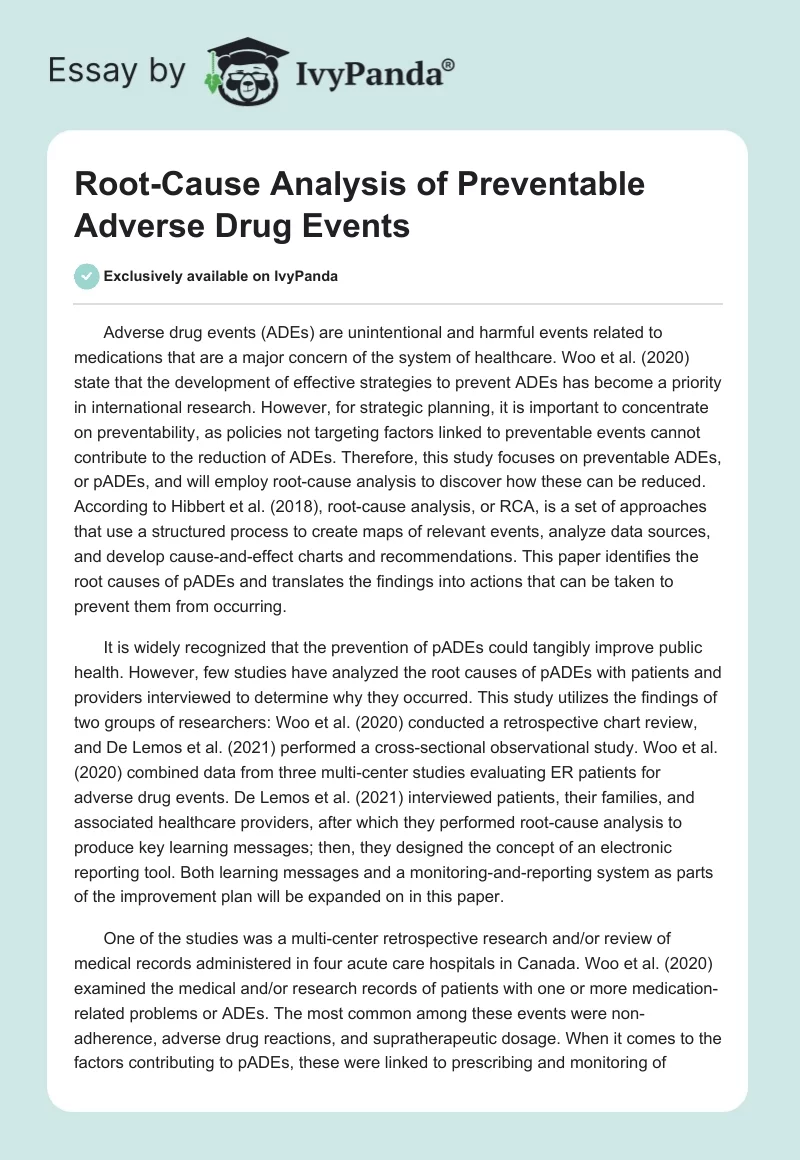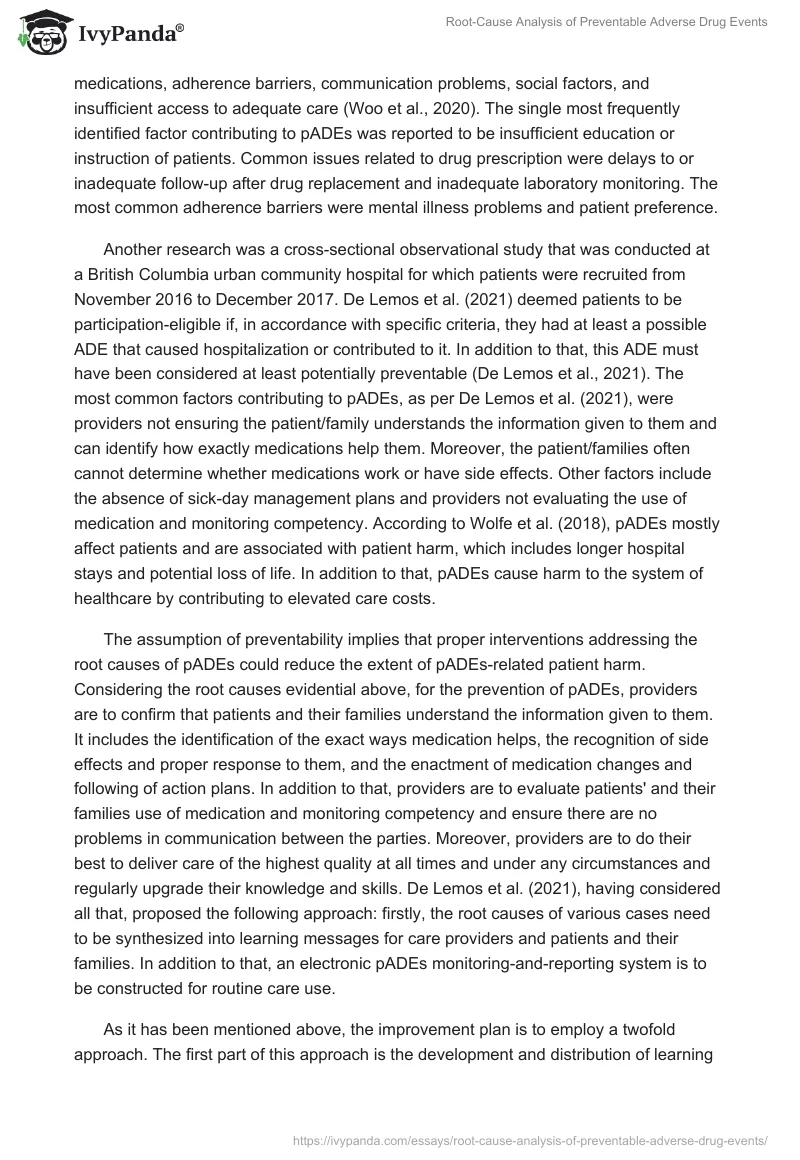Adverse drug events (ADEs) are unintentional and harmful events related to medications that are a major concern of the system of healthcare. Woo et al. (2020) state that the development of effective strategies to prevent ADEs has become a priority in international research. However, for strategic planning, it is important to concentrate on preventability, as policies not targeting factors linked to preventable events cannot contribute to the reduction of ADEs. Therefore, this study focuses on preventable ADEs, or pADEs, and will employ root-cause analysis to discover how these can be reduced. According to Hibbert et al. (2018), root-cause analysis, or RCA, is a set of approaches that use a structured process to create maps of relevant events, analyze data sources, and develop cause-and-effect charts and recommendations. This paper identifies the root causes of pADEs and translates the findings into actions that can be taken to prevent them from occurring.
It is widely recognized that the prevention of pADEs could tangibly improve public health. However, few studies have analyzed the root causes of pADEs with patients and providers interviewed to determine why they occurred. This study utilizes the findings of two groups of researchers: Woo et al. (2020) conducted a retrospective chart review, and De Lemos et al. (2021) performed a cross-sectional observational study. Woo et al. (2020) combined data from three multi-center studies evaluating ER patients for adverse drug events. De Lemos et al. (2021) interviewed patients, their families, and associated healthcare providers, after which they performed root-cause analysis to produce key learning messages; then, they designed the concept of an electronic reporting tool. Both learning messages and a monitoring-and-reporting system as parts of the improvement plan will be expanded on in this paper.
One of the studies was a multi-center retrospective research and/or review of medical records administered in four acute care hospitals in Canada. Woo et al. (2020) examined the medical and/or research records of patients with one or more medication-related problems or ADEs. The most common among these events were non-adherence, adverse drug reactions, and supratherapeutic dosage. When it comes to the factors contributing to pADEs, these were linked to prescribing and monitoring of medications, adherence barriers, communication problems, social factors, and insufficient access to adequate care (Woo et al., 2020). The single most frequently identified factor contributing to pADEs was reported to be insufficient education or instruction of patients. Common issues related to drug prescription were delays to or inadequate follow-up after drug replacement and inadequate laboratory monitoring. The most common adherence barriers were mental illness problems and patient preference.
Another research was a cross-sectional observational study that was conducted at a British Columbia urban community hospital for which patients were recruited from November 2016 to December 2017. De Lemos et al. (2021) deemed patients to be participation-eligible if, in accordance with specific criteria, they had at least a possible ADE that caused hospitalization or contributed to it. In addition to that, this ADE must have been considered at least potentially preventable (De Lemos et al., 2021). The most common factors contributing to pADEs, as per De Lemos et al. (2021), were providers not ensuring the patient/family understands the information given to them and can identify how exactly medications help them. Moreover, the patient/families often cannot determine whether medications work or have side effects. Other factors include the absence of sick-day management plans and providers not evaluating the use of medication and monitoring competency. According to Wolfe et al. (2018), pADEs mostly affect patients and are associated with patient harm, which includes longer hospital stays and potential loss of life. In addition to that, pADEs cause harm to the system of healthcare by contributing to elevated care costs.
The assumption of preventability implies that proper interventions addressing the root causes of pADEs could reduce the extent of pADEs-related patient harm. Considering the root causes evidential above, for the prevention of pADEs, providers are to confirm that patients and their families understand the information given to them. It includes the identification of the exact ways medication helps, the recognition of side effects and proper response to them, and the enactment of medication changes and following of action plans. In addition to that, providers are to evaluate patients’ and their families use of medication and monitoring competency and ensure there are no problems in communication between the parties. Moreover, providers are to do their best to deliver care of the highest quality at all times and under any circumstances and regularly upgrade their knowledge and skills. De Lemos et al. (2021), having considered all that, proposed the following approach: firstly, the root causes of various cases need to be synthesized into learning messages for care providers and patients and their families. In addition to that, an electronic pADEs monitoring-and-reporting system is to be constructed for routine care use.
As it has been mentioned above, the improvement plan is to employ a twofold approach. The first part of this approach is the development and distribution of learning messages. The theme, to be a learning message candidate is to be able to be transformed into particular actions that could be followed to reduce pADEs recurrence. A learning message is to be considered completed only when an investigator committee reviews most potentially pADEs-related message-relevant cases. Messages are to be collected in one document and distributed to local communities’ care providers. Moreover, they are to be presented orally at doctors’ meetings and a special meeting for community pharmacists and nurses. All messages will be released digitally, and pamphlets for patients and their families will be published on local educational websites.
The second part of the approach is the construction of an electronic pADEs monitoring-and-reporting system. In cooperation with the investigator committee, a key stakeholder, a health authority, is to be involved in this tool’s development. This includes the creation of a key performance metric to calculate the rate at which weekly automated reports are to be prepared. In addition to that, plans are to be designed to enhance target users’ reporting/referral of potential pADEs. Furthermore, a reporting structure is to be constructed to share pADE reports with hospitals’ medical leadership and Patient Safety & Quality Committee. Any hospital provider is to have access to this system via hospital’s intranet.
When it comes to existing organizational resources to utilize for the improvement plan, it is, ultimately, the human resources. The first part of the plan calls for the acquiring of learning messages by patients, their families, and care providers. It means that all of them have to put effort into reading corresponding documents or listening to presentations, comprehending the information, and doing their best to realize it into practice. The second part of the plan expects healthcare professionals – from the investigator committee to physicians, pharmacists, and nurses – to participate in the development of the system.
In conclusion, adverse drug events (ADEs), including preventable ones (pADEs), are the healthcare system’s burden and need to be reduced. In this paper, two studies conducting root-cause analysis of pADEs have been reviewed and primary factors contributing to them have been discovered. The improvement plan suggested includes developing and distributing learning messages and creating a pADEs surveillance system. The implementation of these interventions could help ensure fewer adverse events occur and, consequently, reduce patient harm and lower the costs within the healthcare system.
References
De Lemos, J., Loewen, P., Nagle, C., McKenzie, R., You, Y. D., Dabu, A., Zed, P., Ling, P., & Chan, R. (2021). Preventable adverse drug events causing hospitalization: Identifying root causes and developing a surveillance and learning system at an urban community hospital, a cross-sectional observational study.BMJ Open Quality, 10(1), 1-11.
Hibbert, P. D., Thomas, M. J. W., Deakin, A., Runciman, W. B., Braithwaite, J., Lomax, S., Prescott, J., Gorrie, G., Szczygielski, A., Surwald, T., & Fraser, C. (2018). Are root cause analyses recommendations effective and sustainable? An observational study.International Journal for Quality in Health Care, 30(2), 124-131.
Wolfe, D., Yazdi, F., Kanji, S., Burry, L., Beck, A., Butler, C., Esmaeilisaraji, L., Hamel, C., Hersi, M., Skidmore, B., Moher, D., & Hutton, B. (2018). Incidence, causes, and consequences of preventable adverse drug reactions occurring in inpatients: A systematic review of systematic reviews.PloS One, 13(10), 1-36.
Woo, S. A., Cragg, A., Wickham, M. E., Villanyi, D., Scheuermeyer, F., Hau, J. P., & Hohl, C. M. (2020). Preventable adverse drug events: Descriptive epidemiology. British Journal of Clinical Pharmacology, 86(2), 291-302.


